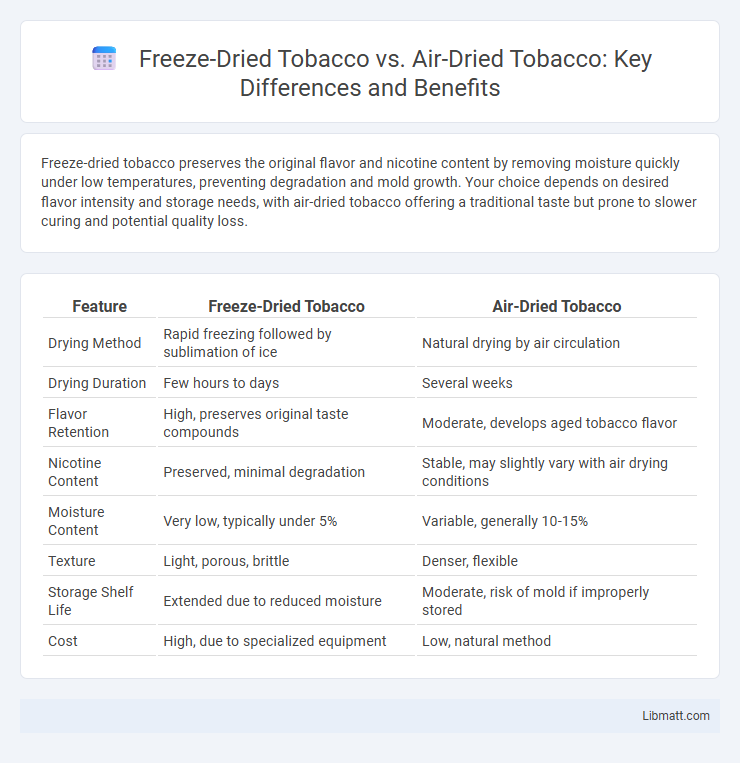Freeze-dried tobacco preserves the original flavor and nicotine content by removing moisture quickly under low temperatures, preventing degradation and mold growth. Your choice depends on desired flavor intensity and storage needs, with air-dried tobacco offering a traditional taste but prone to slower curing and potential quality loss.
Table of Comparison
| Feature | Freeze-Dried Tobacco | Air-Dried Tobacco |
|---|---|---|
| Drying Method | Rapid freezing followed by sublimation of ice | Natural drying by air circulation |
| Drying Duration | Few hours to days | Several weeks |
| Flavor Retention | High, preserves original taste compounds | Moderate, develops aged tobacco flavor |
| Nicotine Content | Preserved, minimal degradation | Stable, may slightly vary with air drying conditions |
| Moisture Content | Very low, typically under 5% | Variable, generally 10-15% |
| Texture | Light, porous, brittle | Denser, flexible |
| Storage Shelf Life | Extended due to reduced moisture | Moderate, risk of mold if improperly stored |
| Cost | High, due to specialized equipment | Low, natural method |
Introduction to Tobacco Drying Methods
Freeze-dried tobacco retains higher levels of volatile compounds and essential oils compared to air-dried tobacco, resulting in a more intense and aromatic flavor profile. The freeze-drying process involves rapid freezing followed by sublimation, which preserves the leaf's cellular structure and nutritional components. In contrast, traditional air-drying relies on slow dehydration in controlled humidity, leading to the gradual oxidation and fermentation that develop characteristic flavors but may reduce volatile compound retention.
What is Freeze-Dried Tobacco?
Freeze-dried tobacco is a preservation method where fresh tobacco leaves are rapidly frozen and then subjected to a vacuum to remove moisture without compromising the leaf's cellular structure. This process retains the tobacco's natural flavors, aromas, and nicotine content more effectively than traditional air-dried methods, which rely on slow dehydration and can sometimes diminish these qualities. Choosing freeze-dried tobacco can enhance your smoking experience by delivering a richer, more consistent taste profile.
What is Air-Dried Tobacco?
Air-dried tobacco is a traditional curing method where harvested tobacco leaves are hung in well-ventilated barns and dried slowly through natural air circulation, preserving their natural sugars and essential oils. This process enhances the leaf's flavor profile, resulting in a smoother, milder tobacco compared to freeze-dried varieties, which undergo rapid dehydration under low temperatures. Understanding how air-dried tobacco maintains moisture and texture can help you choose the ideal type for your smoking experience.
Key Differences Between Freeze-Drying and Air-Drying
Freeze-dried tobacco retains more volatile flavors and nicotine content due to rapid moisture removal under low temperatures, preserving delicate aromatic compounds. Air-dried tobacco undergoes a slower oxidation process that develops a richer, smoother taste but may reduce some heat-sensitive nutrients and aromas. Your choice between freeze-dried and air-dried tobacco depends on whether you prioritize flavor preservation or a traditional taste profile.
Flavor Retention: Freeze-Dried vs Air-Dried Tobacco
Freeze-dried tobacco preserves more volatile flavor compounds compared to air-dried tobacco, resulting in a richer and more intense aroma. The rapid sublimation process in freeze-drying minimizes oxidation and moisture loss, maintaining the tobacco's original flavor profile. Air drying, while traditional, often leads to flavor degradation due to prolonged exposure to ambient air and slower moisture evaporation.
Chemical Composition and Purity
Freeze-dried tobacco retains higher levels of nicotine and essential alkaloids due to minimal heat exposure, preserving chemical composition and purity more effectively than air-dried tobacco. Air-drying can lead to oxidation and microbial contamination, altering chemical constituents and reducing overall purity. Advanced freeze-drying techniques minimize degradation of volatile compounds, maintaining the tobacco's original chemical profile for enhanced quality.
Shelf Life and Storage Stability
Freeze-dried tobacco offers superior shelf life and storage stability compared to air-dried tobacco due to its significantly reduced moisture content, which inhibits mold growth and chemical degradation. The intense dehydration process preserves nicotine potency and flavor compounds, ensuring longer-lasting freshness and usability. If you require tobacco with extended storage duration and consistent quality, freeze-dried options provide a more reliable solution than traditional air-dried methods.
Environmental Impact of Drying Techniques
Freeze-dried tobacco significantly reduces water usage compared to traditional air-drying methods, minimizing environmental strain on local resources. The freeze-drying process also lowers greenhouse gas emissions by shortening drying times and decreasing energy consumption when powered by renewable sources. Your choice of tobacco dried through eco-friendly techniques supports sustainable agriculture and reduces the carbon footprint of tobacco production.
Cost Comparison: Freeze-Dried vs Air-Dried Tobacco
Freeze-dried tobacco incurs higher production costs due to energy-intensive vacuum drying and specialized equipment, resulting in a premium price compared to air-dried tobacco. Air-dried tobacco benefits from natural curing processes that require less energy input, making it more cost-effective for large-scale farming operations. Despite the initial expense, freeze-dried tobacco offers superior moisture retention and flavor preservation, which can justify the investment in niche premium markets.
Which Drying Method is Better for Consumers?
Freeze-dried tobacco maintains higher nicotine content and preserves more natural flavors and aromas compared to air-dried tobacco, offering a richer smoking experience for consumers. Air-dried tobacco undergoes a slower drying process that reduces moisture gradually, resulting in a milder, less intense flavor profile but often with lower potency. Your choice depends on whether you prioritize flavor intensity and nicotine strength (freeze-dried) or smoother, lighter taste (air-dried).
freeze-dried tobacco vs air-dried Infographic

 libmatt.com
libmatt.com